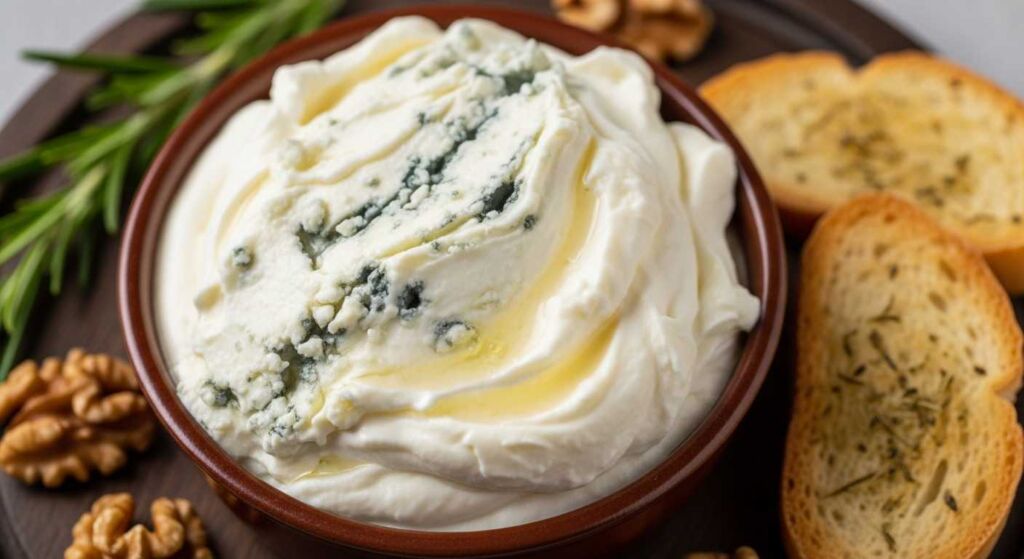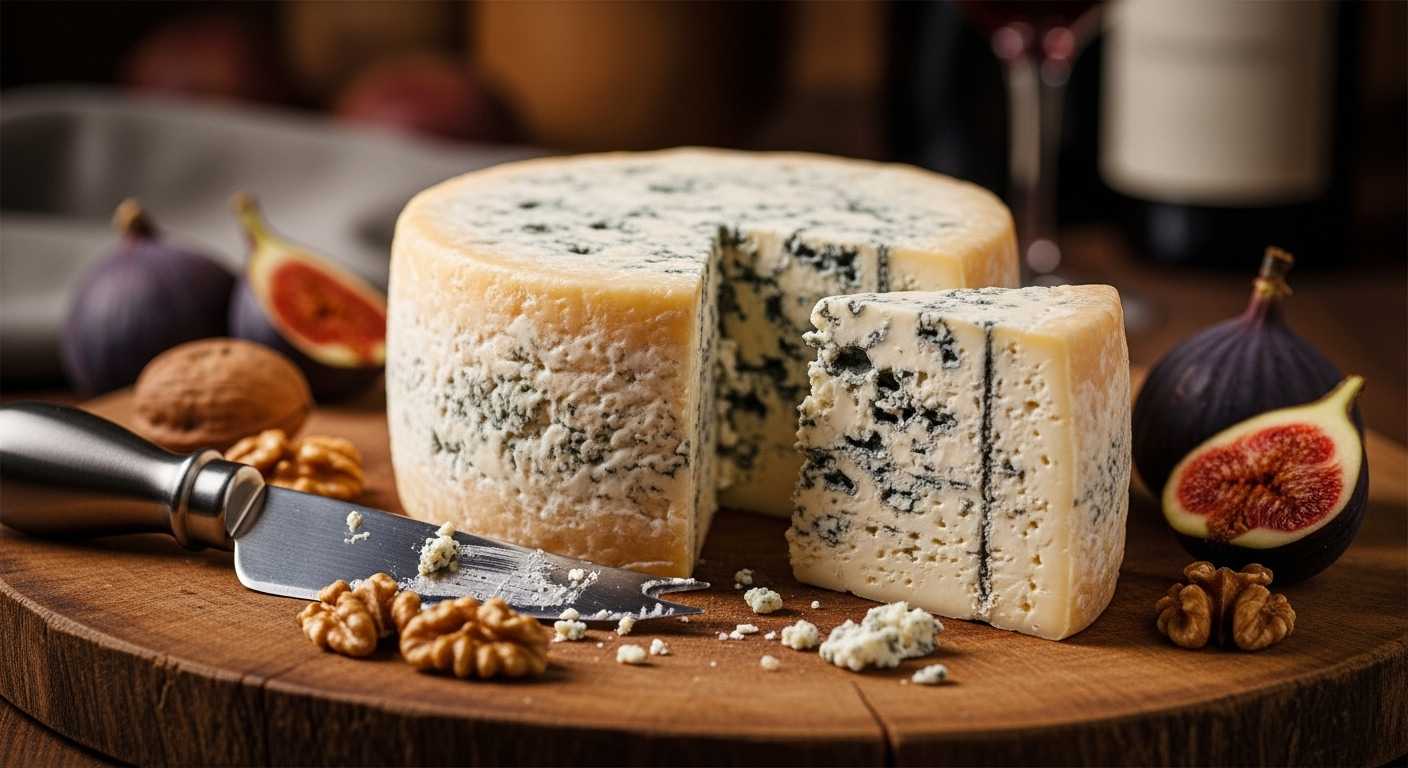Masgonzola is a modern Italian fusion cheese – essentially a marriage of mascarpone and gorgonzola – prized for its creamy texture and balanced tang. Think of it as the perfect harmony between mild and bold: “a luxurious marbled cheese, made by combining silky-smooth mascarpone with the assertive character of blue cheese,” as one food writer described it. In practice, it starts with the rich sweetness of mascarpone and finishes with a gentle blue-cheese tang. This unique blend has captured the foodie imagination by blending Italy’s deep culinary traditions with a fun, modern twist.
Masgonzola often appears on gourmet cheese boards, where its creamy ivory body streaked with blue veins (shown above) really stands out. The marbling of deep-blue mold through a buttery base is “visually striking,” drawing the eye on any platter. Its aroma and appearance hint at the dual nature of the cheese: soft and rich like mascarpone, yet slightly earthy and piquant from the blue cultures.
Origins and Name
The name Masgonzola itself hints at its origins: “Mas” from mascarpone and “Gonzola” from gorgonzola. It’s not an ancient variety with a protected designation of origin, but a creative concept born of Italy’s legendary cheesemaking. Northern Italy – especially Lombardy and Piedmont – is a hotbed of cheese heritage. In fact, Italy boasts over 2,500 traditional cheese varieties, and Lombardy alone produces icons like mascarpone and the famed Gorgonzola. Traditional Gorgonzola PDO dates back centuries (to at least the 9th century) and reflects that heritage. Mascarpone (a Lombardy specialty used in desserts like tiramisu) brings a buttery sweetness. In the late 20th century, artisanal cheesemakers began experimenting by blending these cheeses – to create a milder, more approachable blue cheese experience. (As one lifestyle blog even notes, Masgonzola is more of a “conceptual or cultural reference” than an official product.)
Flavor & Texture Profile
Masgonzola’s big draw is its balanced flavor. Unlike sharper blue cheeses, it is smooth and gentle. At first taste it offers a rich, creamy sweetness, and it finishes with a mild tang of blue mold. Its texture is almost buttery – soft enough to spread yet still sliceable – and it melts into sauces with velvety richness. Experts describe it as having notes of sweet cream and a whisper of earthiness. In short, Masgonzola is “similar to Gorgonzola but less pungent”, offering a “perfect balance of creaminess and subtle aroma”. This makes it ideal even for people who shy away from very sharp blues – you get all the complexity without the overpowering bite.
Culinary Uses
Masgonzola is incredibly versatile in the kitchen. It shines equally in simple snacks and gourmet dishes. Popular ways to use it include:
Cheese Boards & Snacks: Spread it on crusty bread or crackers. Drizzle honey or fig jam on top, and serve with walnuts or grapes for a sweet–savory bite.
Pasta & Risotto: Melt Masgonzola into cream sauces or risottos. Its velvety texture makes for a luxurious, rich sauce (think garlic-Masgonzola penne or mushroom risotto).
Pizza & Flatbreads: Dollop it over pizza (especially with caramelized onions, prosciutto, or figs) for extra depth. It bakes into gooey pockets that elevate a simple Margherita or gourmet pie.
Salads: Crumble it over salads with roasted beets, pears, or arugula. The creaminess pairs beautifully with a balsamic vinaigrette or fresh citrus slices.
Meat & Appetizers: Stuff chicken breasts with Masgonzola and spinach, or top steak and pork chops with a pat of it. It even works in gourmet grilled cheese sandwiches.
Desserts: Believe it or not, Masgonzola makes desserts richer too. Use it in a cheesecake filling, or serve it with fruit and nuts – fresh figs, ripe pears, or a drizzle of honey are classic matches.

Perfect Pairings
To showcase Masgonzola’s nuances, pair it thoughtfully:
Wines: A crisp dry white (like Pinot Grigio) or a medium-bodied red (such as Chianti or Merlot) complements its creaminess. These wines cut the richness without overpowering the cheese.
Fruits & Nuts: Fresh pears, figs, grapes and crunchy walnuts or hazelnuts bring out its subtle tang. (These are classic Italian accompaniments.)
Bread & Savories: Simple crusty bread or focaccia provides a perfect base. For a sweet contrast, try a drizzle of honey or a dollop of fig jam alongside the cheese.
In practice, try a Masgonzola crostini: slice baguette, spread a bit of cheese, then top with fig jam and a walnut – the combination of flavors and textures is immediately addictive.
Nutrition & Health Benefits
Even indulgent cheeses like Masgonzola offer nutritional value when eaten in moderation. It’s a rich source of:
Protein & Healthy Fats: Supports muscle repair and gives lasting energy. (Dairy proteins are high-quality.)
Calcium & Vitamin B12: Essential for strong bones, teeth and nerve function. (A small serving can provide around 10–15% of your daily calcium.)
Probiotics: Traditional aging cultures in the cheese can aid digestion and gut health (much like you’d find in other fermented dairy).
Of course Masgonzola is also fairly high in fat and sodium, so savor it in reasonable portions. But as a treat, it contributes worthwhile nutrients – especially compared to ultra-processed snacks.
Cultural Impact and Trendiness
Masgonzola’s popularity says as much about food culture as about flavor. In the age of Instagram and foodie blogs, it has become a symbol of Italy’s blend of heritage and creativity. Food writers note that it represents a “bridge between tradition and modernity,” reflecting a movement where “food is never just about taste, it’s about identity and connection”. In practice, chefs around the world have embraced it in innovative recipes: you’ll find Masgonzola folded into truffle pasta, whipped into gourmet pizza spreads, and even used in fusion dishes like cheese-filled dumplings or ramen-toppings. Its Instagram-friendly melt and marbling have certainly made it a show-stealer.
As one lifestyle article concludes, “Masgonzola isn’t just a cheese – it’s a story of heritage, innovation, and connection.” From its humble North Italian inspiration to its recent global buzz, Masgonzola embodies how a simple blend of familiar ingredients can spark culinary creativity. Whether you see it as a passing trend or a new classic, it has already influenced the conversation about how tradition can be reinvented on the plate.
Final Thoughts
In summary, Masgonzola brings magic to the table by uniting two well-loved Italian cheeses into one versatile delight. It isn’t a centuries-old PDO cheese, but it has become part of Italy’s living cheese culture – a symbol of craftsmanship meeting contemporary taste. For cheese lovers and adventurous cooks alike, it offers a memorable experience: cool creaminess with a tease of sharpness, best enjoyed alongside good wine and good company.



